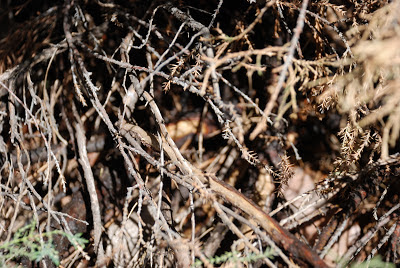 |
| Brown spots are caused by vole damage. photo by Carol King |
The CSU Extension web site has a wealth of information.
Voles are small rodents that measure 4 to 8.5 inches long and weigh 0.8 to 3 ounces and vary in color from brown to gray. They are pudgy, with blunt faces and small eyes, small and sometimes inconspicuous ears, short legs, and a short (the long-tailed vole is an exception) and scantily haired tail. They are often called prairie or field mice.
 |
| Photo CSU Extension |
Eight species of voles are found widely throughout various ecosystems of Colorado, in heavy ground cover of grasses, grass-like plants, and litter.
Voles can cause extensive damage to forests, orchards and ornamental plants by girdling trees and shrubs. They prefer the bark of young trees but will attack any tree, regardless of age, when food is scarce.
 |
| Follow the dead stem to the ground and see the chew marks. Photo by Carol King |
Habitat Management. Elimination of weed ground cover and tall grasses by frequent and close mowing. Prunings left in piles prevent proper mowing and provide a temporary food source, which may lead to damage by voles. Planting short grasses that do not mat or lodge, such as buffalo grass, blue grama, or dwarf fescues, will provide little protective cover and may reduce vole numbers.
Exclusion. To protect against vole damage, encircle young trees and shrubs with 1/4-inch mesh hardware cloth or 3-inch diameter Vexar plastic-mess cylinders. This barrier should project 18 inches above the ground and 3 to 6 inches below the surface. Vegetable and flower beds may also be protected in this manner.
Repellents. Only a few repellents (including thiram and Hot Sauce or capsaicin) are manufactured to protect trees, shrubs and vegetable crops from voles. Little data are available on the effectiveness of repellents to deter vole damage. However, in one study, thiram was reported to reduce damage to apple stems by 78 percent. A 20 percent solution of chicken eggs in water has been effective in reducing deer and elk browsing and may reduce damage by voles.
Trapping. Use mouse snap traps to remove small populations of voles from backyard lawns. Place traps perpendicular to runways with the trigger end in the runway and bait with small amounts of rolled oats or peanut butter. Set traps in the fall before most damage occurs. Trapping is not practical for controlling voles on large areas.
Poison Grain Baits. Rodenticides usually are a short-term solution to damage by voles. Habitat management usually is more successful than rodenticides for eliminating damage in orchards.
Here are some more sources for information:
Managing voles in Colorado.
Identifying and Preventing Vole Damage.
Voles Damage Plants.




